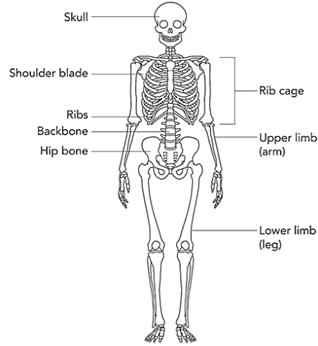What is Movement ?
- The changing position of the body or any part of the body is called movement. The movements occur in our body most of the time.
- Example – When we breath, write, chew something, turn our head and blink our eyes.
Human Body and its Movements
- Bones and muscles work together to cause movements in humans.
- When we walk using our legs, we move our whole body from one place to the other place.
What is locomotion ?
Locomotion is the ability of an organism (Animal , human being etc .) to move or travel from one place to another. Example- walking, running, swimming, flying etc. Locomotion is essential for survival and allows organisms to explore and interact with their environment.
Bones of the Body
- The skeleton of our body is made up of Bones (hard tissues) and cartilage (soft tissue).
- Bone is the hard structural tissue which gives shape to our body.
- Our body consists of many bones.
What are Joints of the Body
- Joints are the places in our body where two bones meet.
- They allow us to move our limbs and make all sorts of movements like bending, twisting, turning etc.
- Joints help to hold our bones together and make sure they move smoothly and easily.
- Joints also provide stability and help to protect our bones from damage.
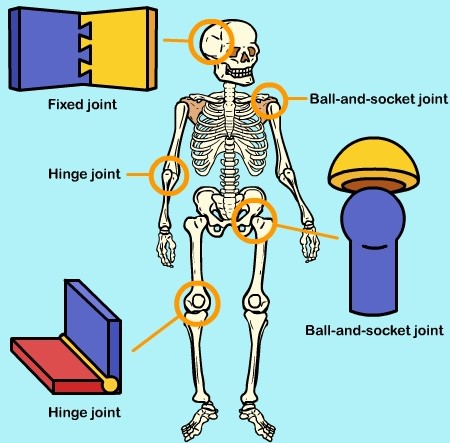
2 Types of Joints
Different types of joints in our body help us to carry out different movements and activities. 2 important types of joints are
- Movable Joints
- Fixed Joints
What are Movable Joints
Movable joints are joints that allow movement between two bones in the body. They allow it to bend, twist, and move in different directions. Movable joints have a small space between the bones which are surrounded by cartilage and ligaments that allow smooth and controlled movement.Examples of movable joints are the knee, elbow, shoulder, hip joints.
3 types of Movable Joints
- Ball and Socket Joints
- Pivotal Joint
- Hinge Joints
Ball and Socket Joints
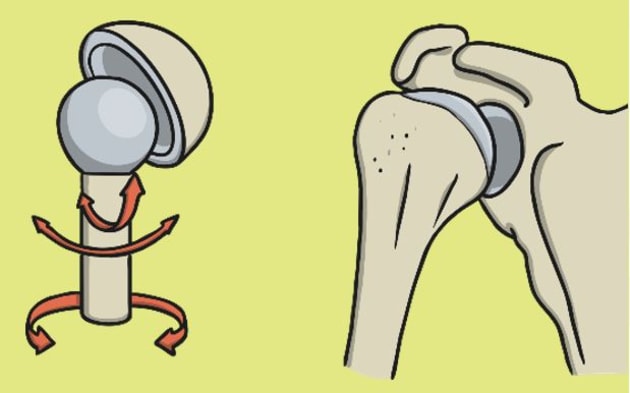
- In these types of joints, one bone is ball-shaped and the other bone provides a hollow socket type space to this ball-shaped bone.
- If we stand up and move our legs in a circle, we will feel that we can rotate our legs making a big circle.
- This type of ball and socket joint is present in our hip joints and shoulder joints.
Pivotal Joint
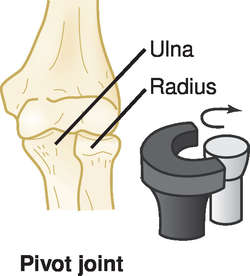
- In this type of joint, the rounded surface of one bone fits into a ring formed by the other, e.g. the joint of the neck and head allows it to move forward and backward and turns the head right or left.
- It allows rotationals movements only.
Hinge Joints
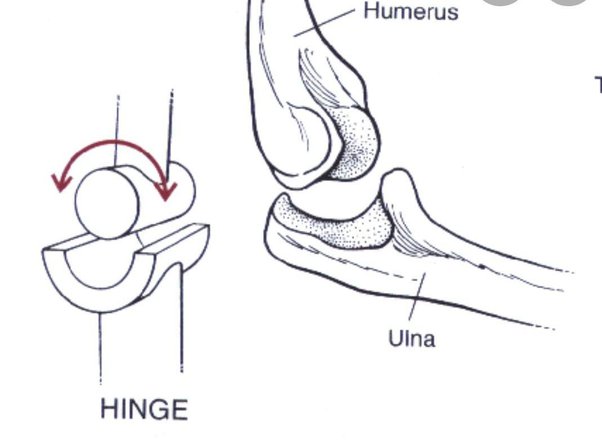
- Some joints of our body move like a door on its hinges.
- These joints allow movement of bones in only one direction, i.e. either forwards or backwards. These are present in the elbow, knee, finger joints and jaw.
Fixed Joints
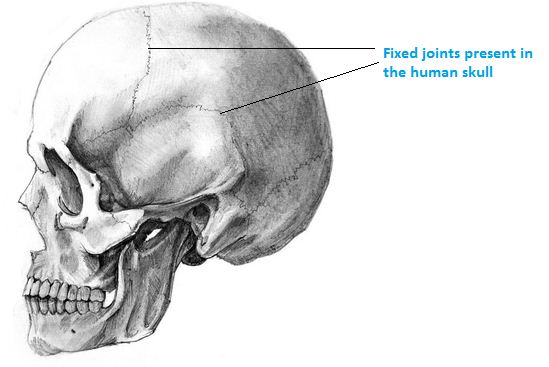
- In some joints, the bones are fixed and held so tightly that they cannot move at all.
- These joints are immovable joints which occur in our skull. The plate type of bones of our skull are held together tightly with such joints.
- Our upper jaw is also fixed to skull bones with the help of fixed joints, e.g. when you open your mouth wide, you can move your lower jaw away from your head
Human Skeleton
- Human skeleton is the internal framework of our body. It is made up of bones and Cartilage that are connected to each other by joints.
- There are 206 bones in the Human skeleton and they work together to provide support and stability to our body.
- Skeleton also protects our internal organs and helps us to move.
- Skeleton is also an important part of our body’s immune system as it contains bone marrow which produces red and white blood cells.
Bones of Skeleton
The skeleton system consists of various bones. Some important bones are as follows.
Skull
- It is the bony part of our head which is made up of 22 small bones.
- These are the hardest bones of our body. Some of these form cranium and some form the facial bones.
- All the bones of the skull except the lower jaw are fixed.
Functions of Skull
- Skull protects the brain.
- It also protects the sense organs of the face (eye, ears and nose).
- Skull gives shape to our face and head.
- Skull contains the jawbone. It allows us to move our jaws and bite and chew food.
- Bones in the skull help transmit sounds to our inner ear, which is necessary for hearing, and also help us produce speech by vibrating when we talk.
Ribcage
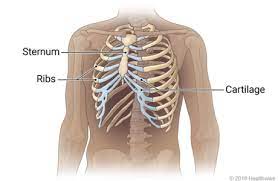
- Ribcage is made up of bones called ribs that are connected to the spine and breastbone.
- The ribs are the curved bones present in our chest region.
- These are 12 pairs of bones which form a cage-like structure.
- One end of the bone joins the backbone, while the other end joins the breast bone in the front.
Functions of Ribcage
- Ribcage protects vital internal organs like heart, lungs, and liver.
- It takes part in our breathing movements along with the lungs.
- Ribcage helps support our upper body and spine.
- Ribcage helps us breathe by moving up and down to expand and contract our lungs.
Backbone
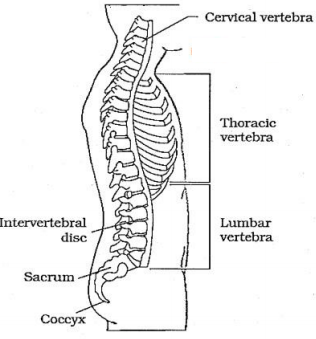
- The Backbone in the human body is also called the spine.
- Backbone which is a long, hollow, rod-like structure running from the neck to the hips.
- It is made up of 33 small bones placed over each other. Each small bone is called vertebrae.
- Between the various vertebrae of backbone are the discs of cartilage (soft bone) which allow the vertebrae to move slightly and enable the backbone to bend forwards and downwards
Functions of Backbone
- Provides Support – The backbone provides support for head, neck, and upper body by helping to keep the body upright and balanced.
- Provides Protection – Backbone protects the spinal cord, which is a bundle of nerves that carries messages from the brain to the rest of the body.
- Movement -Backbone allows the body to bend, twist, and move our bodies in different directions. It allows the body to perform a wide range of movements.
- Shock Absorption – Backbone acts as a shock absorber. It helps to absorb the impact of jumping, running, and other physical activities.
Shoulder Bones
- Arms of our body are attached to our shoulders.
- There are two shoulder bones, i.e collarbones and shoulder blades.
- The upper arm fits into the socket of the shoulder blade (forming ball and socket joint).
Functions shoulder Bones
- Collar bones on the two sides of the neck keep our shoulders apart.
- Shoulder blades attach the arms to our body.
- Shoulder blades provide sites for muscle attachments which move the arms, neck and upper part of the body.
Pelvic Bones
- The pelvic bone forms a large, basin-shaped framework at the lower end of the backbone, to which the legs are attached.
- The pelvic bone is also known as hip bone.
- This bone encloses the portion of the body below the stomach.
- It is also the part of our skeleton we sit on.
Functions of Pelvic Bones
- Pelvic bones protect and support the lower organs of the body like intestines, urinary bladder, internal sex organs, etc.
- It attaches the legs to our body.
- It provides sites for the attachment of muscles that move our legs, hips, trunk, etc.
Bones of the Hand

Our hand is made up of the three parts, i.e. wrist, palm and fingers.
The number of bones present in these parts are:
- Wrist – 8 Small carpals
- Palm – 5 long metacarpals
- Fingers – 3 bones in each finger called phalanges.
- Thumbs – Thumbs are made up of 2 bones each.
What is Cartilage?
- Cartilage is a flexible, rubbery material that acts as a cushion between bones, helping to absorb shock and prevent friction between them.
- Cartilage is important to maintain the shape and stability of the body.
- Cartilage is also essential for smooth, pain-free movement of the body .
- Cartilage is present in the pinna of ears (upper part).
- Cartilage is present at the end of the nose.
- Cartilage is also present (as cartilage discs) between the vertebrae of backbone.
- Cartilage is present on the end of bones where they meet one another at a joint.
Muscles
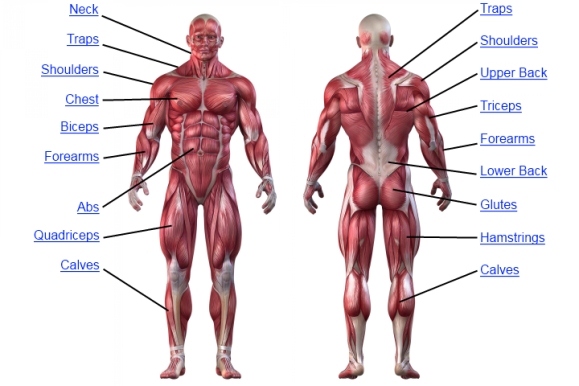
- Muscles are a soft tissue consisting of muscle fibers.
- Muscles are attached to the bones of our skeleton.
- Muscles work by contracting and relaxing. When a muscle contracts, it shortens in length and becomes thicker. This helps us to move our body and perform physical activities. When a muscle relaxes, it returns to its original length and shape.
- It pulls the bone due to which the bone moves at the joint.
- The muscles joined to our bones work in pairs. This is because a muscle can only pull
- a bone, it cannot push a bone. Thus, two muscles have to work together to move a bone.
- When one muscle of the pair contracts (or shortens), then the other muscle of the pair relaxes.
- To move the bone in the opposite direction, the relaxed muscle contracts to pull the bone towards its original position, while the first relaxes. e.g. the up and down movements of our arms are controlled by two muscles, i.e. biceps (flexor) and triceps (extensor). When we want to raise our arm, the biceps in front contract, i.e. they become shorter to pull up the arm. To lower the arm, the triceps at the back contract and pull it down.
Movement of Animals
Different animals use different organs to move from one place to another. Movement also differs in different animals for example – birds-fly, fish-swim and snakes-crawl.
Movement of few animals are as follows
Movement in Earthworm
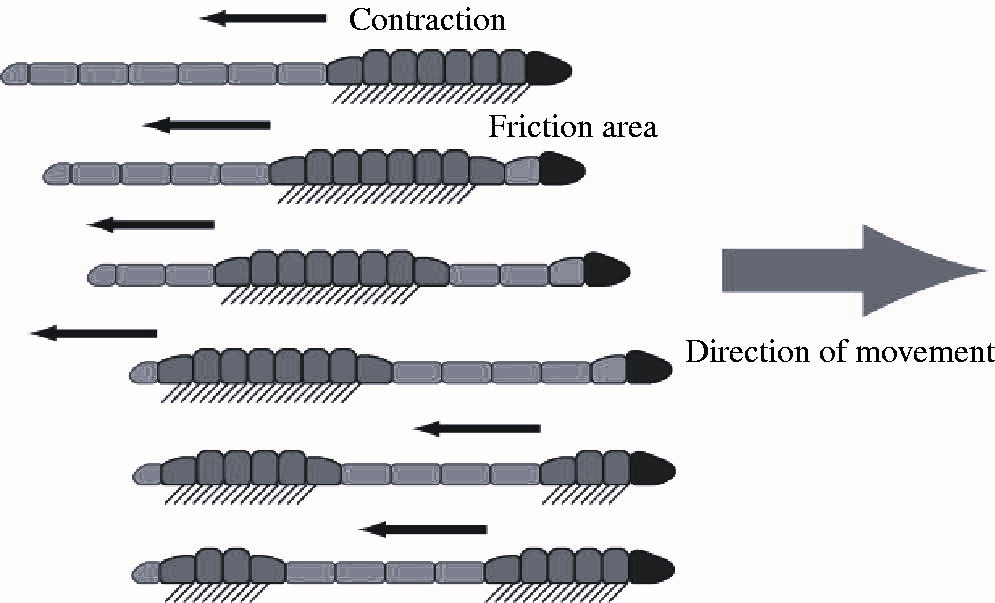
- Earthworms do not have legs and bones.
- It moves by alternate expansion and contraction of the body affected by the muscles.
- During movement, the earthworm first extends the front part of the body, keeping the rear portion fixed to the ground. Then it fixes the front end and releases the rear end.
- After releasing the rear end, it then shortens the body and pulls the rear end forward.
- This makes it move forward by a small distance.
- Earthworms body secretes a slimy substance to help the movement.
- The minute movable bristles help in gripping the ground. The bristles are hair-like structures projecting out of the body of the Earthworm. These are connected with muscles.
- Earthworm is very useful for farmers as it increases the fertility of soil.
- The earthworm eats its way through the soil and throws away the undigested part of the material that it eats.
- In this way, an earthworm makes the soil more fertile for plants.
- Earthworms are easily seen in the rainy season. observe an earthworm moving on soil in a garden.
Movement in Snail
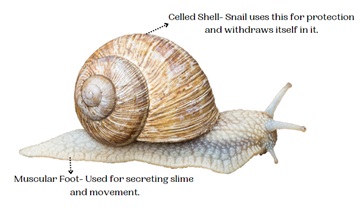
- The body of the snail is covered with a hard shell.
- The body is soft and consists of head, foot and shell.
- The foot is a large, secret slimy substance which helps the snail slide over the ground, dragging its heavy shell with it.
- The movement of the foot is slow and is controlled by muscles attached to it.
Movement in Cockroach
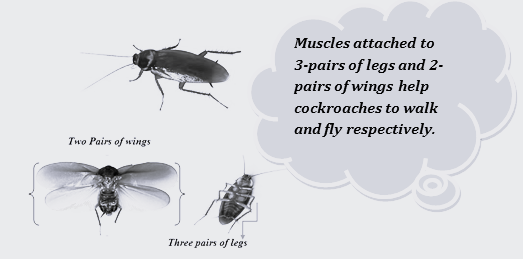
- Cockroaches can walk, climb and fly upto a short distance.
- The body of a cockroach is covered with a hard outer skeleton (exoskeleton) made up of chitin. They have three pairs of joint legs attached to the breast region which help them to walk.
- The two pairs of wings are also attached to the breast.
- The breast muscles move the wings when the cockroach flies
Movement in Bird

- The birds can walk with two legs as well as fly with wings.
- The bones of hind legs of birds help them to walk and perch.
- While flying the chest muscles help the birds to flap their wings.
- Their bones are hollow to make them light weighted.
- The forelimbs are modified into wings to fly.
- Ducks and swans can swim in water.
Movement In Fishes
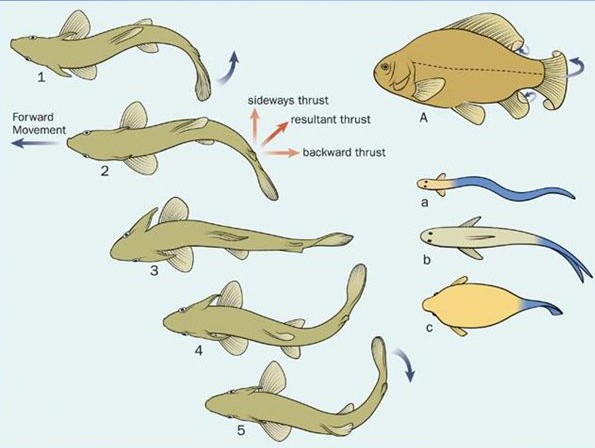
- The body of the fish is like a boat and is called streamlined which helps the fish in its movement. The skeleton of the fish is covered with muscles.
- During swimming, the muscles make the front part of the body curve to one side, while the tail part swings towards the opposite side. The fish thus forms a curve. This makes the jerks and pushes the body forward and help in their movement.
Movement in Snake
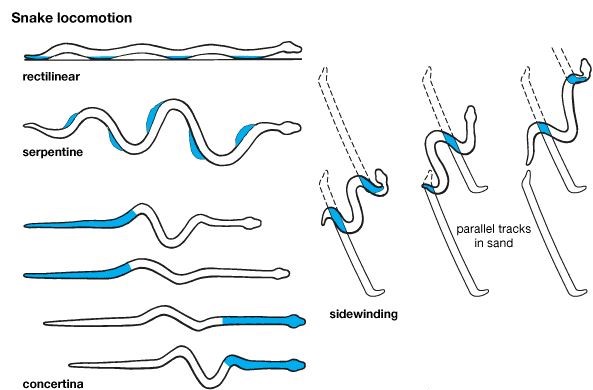
- Snakes are vertebrates. It has a long backbone which is very flexible. The snake can curve boy
- its body into many loops.
- Each loop pushes the ground to give a forward push to the body against the ground.
- This movement is supported by vertebrae present in the backbone and
- the muscles. The muscles are connected to each other. Backbone, ribs and skin are also
- connected to the muscles.
- This kind of movement in snakes is called Slithering.
Did you find this article helpful? We’d love to hear your thoughts and suggestions in the comments!
